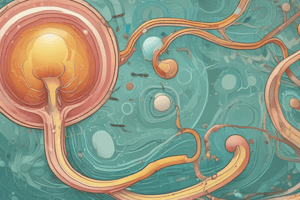Podcast
Questions and Answers
What is the primary purpose of urinalysis?
What is the primary purpose of urinalysis?
- To diagnose kidney damage, urinary tract infections, or systemic problems (correct)
- To measure the pH of urine
- To detect metabolites from drugs
- To determine pregnancy
What does the presence of bilirubin in urine indicate?
What does the presence of bilirubin in urine indicate?
- Liver disease (correct)
- Kidney damage
- Urinary tract infection
- Hypertension
What is the normal pH range of urine?
What is the normal pH range of urine?
- 5.5 - 7.5
- 5.5 - 8.5
- 4.5 - 8 (correct)
- 4.5 - 6.5
What is the primary component of urine?
What is the primary component of urine?
What is the typical color of urine?
What is the typical color of urine?
What is the normal range of urine volume in a 24-hour period?
What is the normal range of urine volume in a 24-hour period?
What is the purpose of measuring urine volume during a urinalysis?
What is the purpose of measuring urine volume during a urinalysis?
What is the significance of ketones in urine?
What is the significance of ketones in urine?
What can measuring urine output help identify?
What can measuring urine output help identify?
What can be indicated by a pink color of urine?
What can be indicated by a pink color of urine?
What is usually associated with urine that contains few waste products?
What is usually associated with urine that contains few waste products?
What can a strong ammonia odor in urine indicate?
What can a strong ammonia odor in urine indicate?
What can cloudy urine indicate?
What can cloudy urine indicate?
Why is it important to ask follow-up questions to the patient if the patient's results are unusual?
Why is it important to ask follow-up questions to the patient if the patient's results are unusual?
What can alter the smell of urine?
What can alter the smell of urine?
What can a sweet, ketone smell in urine indicate?
What can a sweet, ketone smell in urine indicate?
What can help guide diagnosis in addition to follow-up questions to the patient?
What can help guide diagnosis in addition to follow-up questions to the patient?
Urine is typically composed of ~99% water and 1% dissolved ions.
Urine is typically composed of ~99% water and 1% dissolved ions.
The presence of leukocytes in urine is a normal finding.
The presence of leukocytes in urine is a normal finding.
Urine usually has a strong ammonia smell.
Urine usually has a strong ammonia smell.
Urine with a pH of 7 is considered acidic.
Urine with a pH of 7 is considered acidic.
Urinalysis can detect pregnancy.
Urinalysis can detect pregnancy.
Urine volume typically ranges from 100 ml to 200 ml per urination.
Urine volume typically ranges from 100 ml to 200 ml per urination.
Urine with a pink color is normal.
Urine with a pink color is normal.
Urinalysis is only used to screen for urinary tract infections.
Urinalysis is only used to screen for urinary tract infections.
Urine that contains many waste products usually has little to no odor.
Urine that contains many waste products usually has little to no odor.
A sweet, ketone smell in urine is a normal characteristic of healthy individuals.
A sweet, ketone smell in urine is a normal characteristic of healthy individuals.
Urine color cannot be affected by certain foods consumed by the patient.
Urine color cannot be affected by certain foods consumed by the patient.
Cloudy urine always indicates a urinary tract infection.
Cloudy urine always indicates a urinary tract infection.
Measuring urine output can help identify only chronic kidney disease.
Measuring urine output can help identify only chronic kidney disease.
A pink color of urine is always indicative of the presence of blood.
A pink color of urine is always indicative of the presence of blood.
Asparagus consumption can change the smell of urine.
Asparagus consumption can change the smell of urine.
A strong ammonia odor in urine is always a sign of dehydration.
A strong ammonia odor in urine is always a sign of dehydration.
Normal urine is usually cloudy.
Normal urine is usually cloudy.
Flashcards are hidden until you start studying
Study Notes
Urinalysis
- Urinalysis is a diagnostic test that analyzes the characteristics and constituents of urine to detect various health conditions.
Urine Composition
- Normally, urine comprises 96% water and 4% dissolved ions, metabolic wastes, and other metabolites.
- Urochrome, a byproduct of heme degradation, gives urine its pale yellow color.
- Urine typically has an average pH of 6, ranging from 4.5 to 8.
Urine Volume
- Normal urine volume is 800 to 2,000 mL per day over 24 hours.
- Single urination volume typically ranges from 210 mL to 500 mL.
- Measuring urine output helps identify disorders like dehydration, inadequate fluid intake, or chronic kidney disease.
Urine Color
- Urine color can indicate dehydration or excess water intake.
- Pink urine may indicate the presence of blood or consumption of certain foods like beets.
- Urine color can be influenced by diet and medications.
Urine Odor
- Hydrated urine has little to no odor, while concentrated urine can have a strong ammonia smell.
- Certain foods and medications can alter the smell of urine.
- Unusual odors may indicate medical disorders, such as diabetic ketoacidosis.
Urine Precipitate
- Normally, urine is clear of precipitate.
- Cloudy urine may indicate cellular materials or proteins, which can suggest dehydration, high protein diet, urinary tract infection, or kidney damage.
- Follow-up questions and additional analysis, like urinalysis, can guide diagnosis.
Urinalysis
- Urinalysis is a diagnostic test that analyzes the characteristics and constituents of urine to detect various health conditions.
Urine Composition
- Normally, urine comprises 96% water and 4% dissolved ions, metabolic wastes, and other metabolites.
- Urochrome, a byproduct of heme degradation, gives urine its pale yellow color.
- Urine typically has an average pH of 6, ranging from 4.5 to 8.
Urine Volume
- Normal urine volume is 800 to 2,000 mL per day over 24 hours.
- Single urination volume typically ranges from 210 mL to 500 mL.
- Measuring urine output helps identify disorders like dehydration, inadequate fluid intake, or chronic kidney disease.
Urine Color
- Urine color can indicate dehydration or excess water intake.
- Pink urine may indicate the presence of blood or consumption of certain foods like beets.
- Urine color can be influenced by diet and medications.
Urine Odor
- Hydrated urine has little to no odor, while concentrated urine can have a strong ammonia smell.
- Certain foods and medications can alter the smell of urine.
- Unusual odors may indicate medical disorders, such as diabetic ketoacidosis.
Urine Precipitate
- Normally, urine is clear of precipitate.
- Cloudy urine may indicate cellular materials or proteins, which can suggest dehydration, high protein diet, urinary tract infection, or kidney damage.
- Follow-up questions and additional analysis, like urinalysis, can guide diagnosis.
Studying That Suits You
Use AI to generate personalized quizzes and flashcards to suit your learning preferences.




